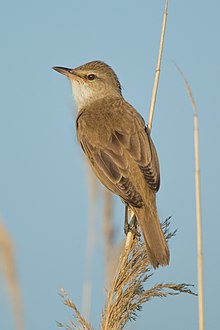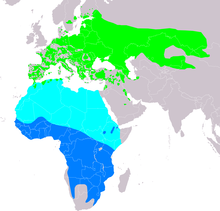| Great reed warbler | |
|---|---|

| |
| Adult at a bird banding station | |
| Scientific classification | |
| Domain: | Eukaryota |
| Kingdom: | Animalia |
| Phylum: | Chordata |
| Class: | Aves |
| Order: | Passeriformes |
| Family: | Acrocephalidae |
| Genus: | Acrocephalus |
| Species: | A. arundinaceus
|
| Binomial name | |
| Acrocephalus arundinaceus | |

| |
| Range of A. arundinaceus Breeding Passage Non-breeding
| |
| Synonyms | |
|
Turdus arundinaceus Linnaeus, 1758 | |
The great reed warbler (Acrocephalus arundinaceus) is a Eurasian bird in the passerine genus Acrocephalus.
The genus name Acrocephalus is from Ancient Greek akros, "highest", and kephale, "head". It is possible that Naumann and Naumann thought akros meant "sharp-pointed". The specific arundinaceus is from Latin and means "like a reed", from arundo, arundinis, "reed".[3]
It used to be placed in the Old World warbler assemblage, but is now recognized as part of the marsh and tree-warbler family (Acrocephalidae). Great reed warblers are medium-sized birds and are the largest of the European warblers. They breed throughout mainland Europe and the west Palearctic and migrate to sub-Saharan Africa in the winter. [4] Great reed warblers favour reed beds as their habitat during breeding months, while living in reed beds, bush thickets, rice fields, and forest clearings during the winter. Great reed warblers exhibit relatively low sexual dimorphism, and both genders of the species are similar in appearance. This species mates both polygynously and monogamously.
- ^ BirdLife International (2017). "Acrocephalus arundinaceus". IUCN Red List of Threatened Species. 2017: e.T104317670A111179363. doi:10.2305/IUCN.UK.2017-1.RLTS.T104317670A111179363.en. Retrieved 12 November 2021.
- ^ For instance in Gould, John (1873). The Birds of Great Britain. Vol. II. pp. Plate LXXII (and accompanying text).. See also: Digital Collections, The New York Public Library. "(still image) Acrocephalus turdoïdes. Thrush-Warbler., (1862 - 1873)". The New York Public Library, Astor, Lennox, and Tilden Foundation. Retrieved July 17, 2019.
- ^ Jobling, James A (2010). The Helm Dictionary of Scientific Bird Names. London: Christopher Helm. pp. 30, 56. ISBN 978-1-4081-2501-4.
- ^ Sjöberg, Sissel; Malmiga, Gintaras; Nord, Andreas; Andersson, Arne; Bäckman, Johan; Tarka, Maja; Willemoes, Mikkel; Thorup, Kasper; Hansson, Bengt; Alerstam, Thomas; Hasselquist, Dennis (2021-05-07). "Extreme altitudes during diurnal flights in a nocturnal songbird migrant". Science. 372 (6542): 646–648. Bibcode:2021Sci...372..646S. doi:10.1126/science.abe7291. ISSN 0036-8075.
